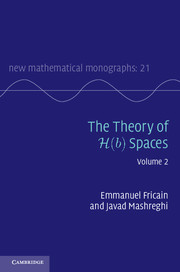Book contents
- Frontmatter
- Dedication
- Contents
- Miscellaneous Frontmatter
- Preface
- 16 The spaces M(A) and H(A)
- 17 Hilbert spaces inside H2
- 18 The structure of H(b) and H(b)
- 19 Geometric representation of H(b) spaces
- 20 Representation theorems for H(b) and H(b)
- 21 Angular derivatives of H(b) functions
- 22 Bernstein-type inequalities
- 23 H(b) spaces generated by a nonextreme symbol b
- 24 Operators on H(b) spaces with b nonextreme
- 25 H(b) spaces generated by an extreme symbol b
- 26 Operators on H(b) spaces with b extreme
- 27 Inclusion between two H(b) spaces
- 28 Topics regarding inclusions M(a) ⊂ H(b) ⊂ H(b)
- 29 Rigid functions and strongly exposed points of H1
- 30 Nearly invariant subspaces and kernels of Toeplitz operators
- 31 Geometric properties of sequences of reproducing kernels
- References
- Symbol index
- Author index
- Subject index
17 - Hilbert spaces inside H2
Published online by Cambridge University Press: 20 October 2016
- Frontmatter
- Dedication
- Contents
- Miscellaneous Frontmatter
- Preface
- 16 The spaces M(A) and H(A)
- 17 Hilbert spaces inside H2
- 18 The structure of H(b) and H(b)
- 19 Geometric representation of H(b) spaces
- 20 Representation theorems for H(b) and H(b)
- 21 Angular derivatives of H(b) functions
- 22 Bernstein-type inequalities
- 23 H(b) spaces generated by a nonextreme symbol b
- 24 Operators on H(b) spaces with b nonextreme
- 25 H(b) spaces generated by an extreme symbol b
- 26 Operators on H(b) spaces with b extreme
- 27 Inclusion between two H(b) spaces
- 28 Topics regarding inclusions M(a) ⊂ H(b) ⊂ H(b)
- 29 Rigid functions and strongly exposed points of H1
- 30 Nearly invariant subspaces and kernels of Toeplitz operators
- 31 Geometric properties of sequences of reproducing kernels
- References
- Symbol index
- Author index
- Subject index
Summary
In this chapter, our ambient Hilbert space is H2, the Hardy space of the open unit disk D. Using contractive Toeplitz operators on H2, we apply the theory developed in Chapter 16 to obtain some new Hilbert spaces of analytic functions that live inside H2. In particular, we introduce the H(b) spaces.
In Section 17.1, we introduce theM(u) spaces, where u ∈ L∞(T). When u is analytic, this space is particularly simple and in this case we characterize some inclusions between two M(u) spaces. In Section 17.2, we study the case when u is antianalytic. Then, in Section 17.3, we introduce the space that is the main theme of our book, the H(b) space. The rest of the book is devoted to understanding this important (and as yet mysterious) space. The cousin of the H(b) space, the H(b) space, is introduced in Section 17.4. As we will see, it is impossible to separate the study of H(b) from that of H(b). The relation between two H(b) spaces is studied in Section 17.5. Since more tools are needed, the analogous result for H(b) spaces is stated in Chapter 27. In Section 17.6, we show that M(u) and M(u), u ∈ H∞, are invariant with respect to the backward shift operator S*. In Section 17.7, we prove that M(u) is contractively included into M(u). The problem of the similarity of S and SH is studied in Section 17.8. In Section 17.9, we describe the invariant subspaces with respect to X.u = S∗ M(.u). In Section 17.10, we extend the result of Beurling proved in Volume 1 (see Section 8.8). Recall that Beurling's theorem describes the closed subspaces of H2 that are invariant with respect to S. Here, we describe the Hilbert spaces H, which are contractively included in H2, which are invariant with respect to S and such that S acts as an isometry.
The spaceM(u)
Let u L∞(T). Then the Hilbert spacesM(Tu) andM(Tu) are well defined. For simplicity, we denote them respectively by M(u) and M(u). We study some of their elementary results below. We will be concerned with the special, but important, case.
- Type
- Chapter
- Information
- The Theory of H(b) Spaces , pp. 44 - 68Publisher: Cambridge University PressPrint publication year: 2016



